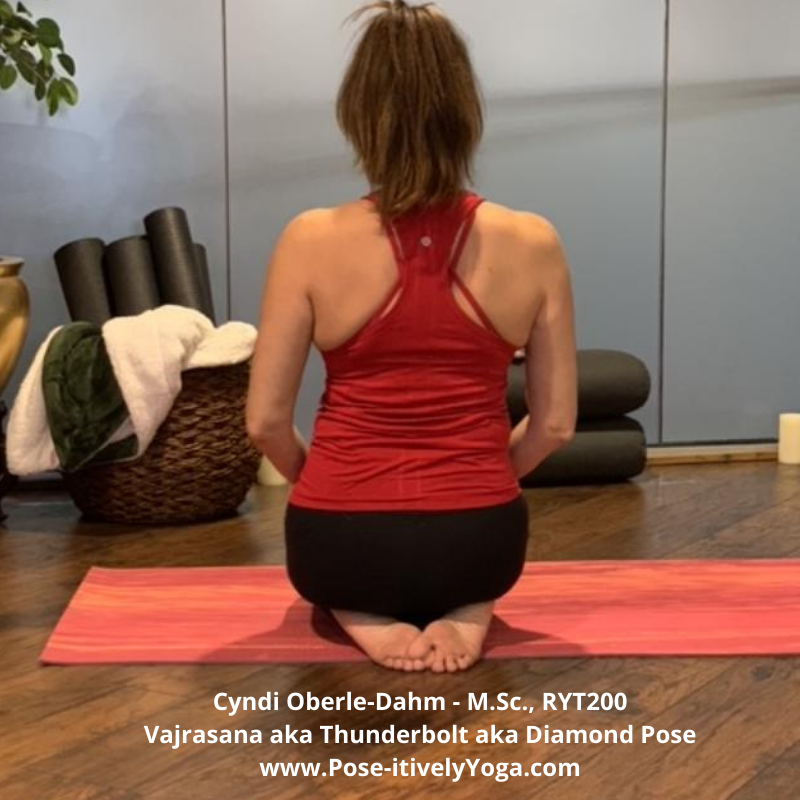Virasana (Hero Pose) vs. Vajrasana (Thunderbolt)
These two (2) poses are often confused or interchanged. The subtle difference changes the elevation of the hips.
Virasana - Hero Pose
(Sitting between the ankles)
Virasana is a Sanskrit word, which means Hero Pose. Vira means ‘hero’ and asana means ‘pose’.
Vira is slightly similar to Virabhadra, which means ‘warrior’ or ‘mystical warrior’, as in Virabhadrasana 1, 2 or 3, meaning Warrior 1, 2 or 3.
In the yogic sense, the ‘hero’ is the one who safeguards oneself by overcoming inner turmoil.
Virasana is a basic meditative pose and should be practiced on an empty stomach. When practicing as a meditation, this pose is best early in the morning or late evening, although it can be used during any yoga practice.
Contraindications - Those suffering from a heart issues, headaches, migraines or knee issues. This is likely due to the soleus muscle, which is well-known as ‘the second heartbeat’, having an unusually large amount of stress and/or torsion to the belly of the muscle. Read more about the Soleus Muscle and the second heartbeat here in article on this website.
*Keep reading below these 2 pics for cue guidance.
Stand on your knees with your knees in alignment with your hips. Separate your heels so that they are just wider than your hips. As you set your seat back toward the space between your ankles, take your thumbs behind the knee, just above the calf, and pull the tissue away from midline, then set your seat all the way back placing your hips in-between your ankles. Your knees should be in alignment with your hips and your heels should be on the outside of your hips with the dorsal side down (top of the foot or pedicure side down). You may also gently lift up each knee and then lay it back down to create more space and comfort.
You may also use a block, bolster or blanket in-between your ankles to elevate your hips.
*Keep reading for Vajrasana - Thunderbolt Pose
Vajrasana - Thunderbolt Pose
(Sitting on the heels)
Vajrasana is a Sanskrit word, which means Thunderbolt or Diamond Pose. Vajra means ‘thunderbolt’ or ‘diamond’ and asana means ‘pose’. Vajrasana is also a ‘full body mudra’ as is Mahamudra (similar to Janu Sirsasana) and Viparita Karini (legs up the wall). Read more about mudras here!
This asana brings a deep stretch to the quadriceps, along with the front of the shins, front of the ankles and the tops of the feet. This asana aids in digestion and relief when on long road trips.
Vajrasana is often used as a transitional asana and is often used as an asana for meditation.
Contraindications - Those suffering from a hernia, ulcer, pregnancy or knee issues.
**Great toe (big toe) placement will depend on the dominant nostril breathing. The nostril side that is stronger or more dominant will be the toe that is placed on the other. In the picture you can Cyndi’s right great toe placed on top of her left great toe. This means her right side nostril was the dominant breathing nostril. Nostril dominance may change day-to-day or practice-to-practice.
*Keep reading below these 2 pics for cue guidance.
Stand on your knees, big toes and ankles to touch. Your knees should be in alignment with your hips with the dorsal side down (top of the foot or pedicure side down). As you set your seat back to sit on your heels, take your thumbs behind the knee, just above the calf, and pull the tissue away from midline, then set your seat all the way back placing your hips on your heels. You may also gently lift up each knee and then lay it back down to create more space and comfort.
You may also use a block, bolster or blanket in-between your ankles to elevate your hips.











